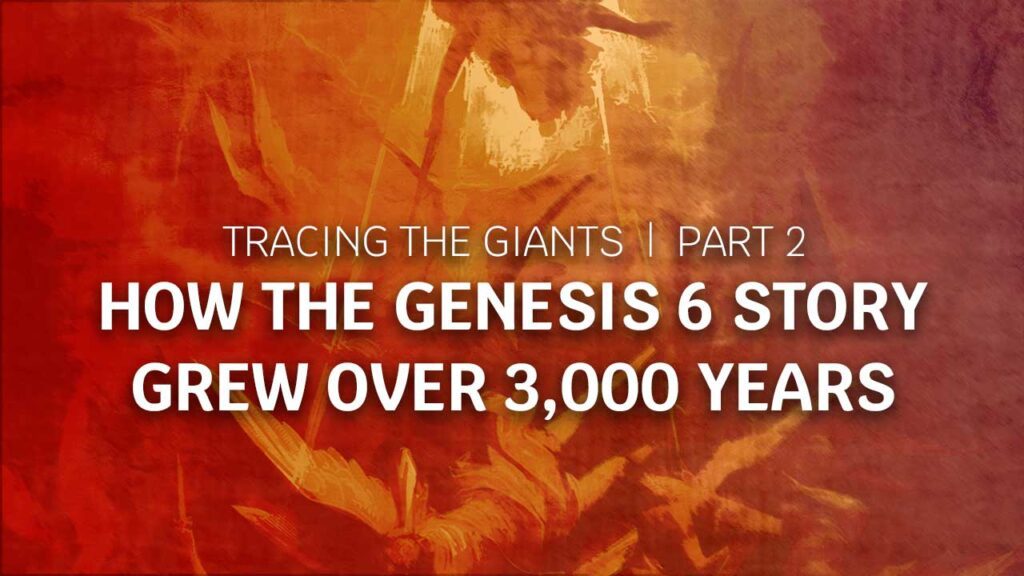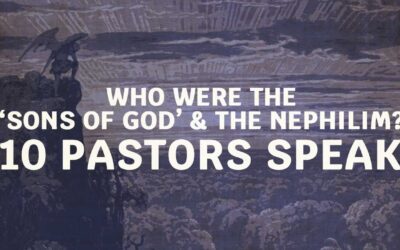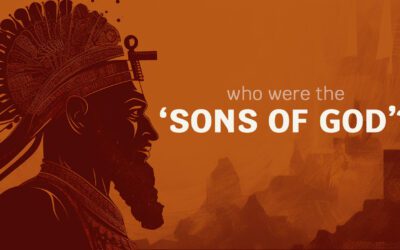
So you’re interested in knowing how the whole story of the Nephilim evolved over the millennia?
In most articles and even books on the topic of the Nephilim and their origin, this timeline is skipped. But having a clear understanding of this timeline is essential to understanding the actual context for many of the subsequent articles that follow.
If we really want answers to questions about the Nephilim and the ‘sons of God’, we need to know where the story comes from in the first place.
The Origins of the ‘sons of God’ in Genesis and Ancient Myths
In Genesis 6, and to varying degrees in some early creation myths, the story goes that there was some kind of intermingling between heaven and earth (Hesiod, Genesis) that produced offspring that were called the nephilim and/or giants.
The original passage in Genesis is very brief, as are some of the myths themselves. It can be hard to pinpoint exactly which aspects of the most ancient myths parallel Genesis exactly, but several researchers have done considerable work in untangling this question and providing evidence of the overlap between them.
Even though the supernatural origin of the masculine perpetrators of this deed has been debated, it’s generally accepted that the oldest known interpretations of these actors (beginning around the 3rd century BC or arguably earlier) were that they were angels of supernatural origin, not men. That interpretation is debated to this day, but it will be covered later in this series.
In Greek myth, popularized by Hesiod around 700 BC, the origin of the Titans and the giants was definitely not from mortals.
And the majority of the most ancient recorded Jewish and Christian interpretations were that the ‘sons of God’ were angels ‘leaving their proper place’ and doing something outside of their calling and nature. (Josephus, Philo, Ben Hyrcanus, Justin Martyr, Iraenus, Athenagoras, Clement, Tertullian, Eusebius, etc.)
The Origins of the Nephilim in Genesis and Ancient Mythology

The offspring of these unions are connected to stories of famous ‘heroes of old’ and giants, but not always (Sanchuniathon, Josephus, Genesis, Philo of Alexandria).
for the tradition is, that these men did what resembled the acts of those whom the Grecians call giants.
Josephus | Antiquities of the Jews, First Century Ad
In many tales, these famous personalities were literal giants – taller than the average human (Beowulf, Hesiod, Ovid, Claudian, etc.). Although many Christian commentators (ancient and modern) still maintain this view, it’s another debated topic.
For the sake of brevity in this article, the Genesis account simply informs the readers that they had heard of these men before, and identifies the point in the Biblical timeline where the stories of these famous men had originated.
These were the mighty men who were of old, the men of renown.
Genesis 6: 4
That’s more or less how it functions in the narrative leading up to the flood account.
War between Heaven and Earth

Another common theme was that there was a rebellion between the original gods and the new gods, or between gods in heaven and earth itself (Enuma Elish, Hesiod, Siculus, etc).
…they launched from their strong hands and overshadowed the Titans with their missiles, and buried them beneath the wide-pathed earth, and bound them in bitter chains when they had conquered them by their strength for all their great spirit, as far beneath the earth to Tartarus…
Hesiod’s Theogony, C. 700 BC
There by the counsel of Zeus who drives the clouds the Titan gods are hidden under misty gloom, in a dank place where are the ends of the huge earth. And they may not go out…
This aspect is never explicitly spelled out in Genesis, although this storyline has been compared to ideas about Satan’s origins and/or the rebellion of the Watchers later expounded upon by the Book of Enoch, Jude, Peter and others.
Enochian and other 2nd Century Writings build on the Legends
So far we’ve bounced around a bit, but our focus has remained on the interpretation of Genesis 6:1-4 and of related myths. So when you fast forward, a few centuries, you get to a massive boom in ancient writings that expand significantly upon the enigmatic four verses of Genesis.
For context, this was a few centuries before Jesus was born, and the Jews were in exile in Babylon, and they were exposed to all kinds of pagan influences.
Such influences would be stories of demigod heroes, whose parents were both of heaven and earth that formed the basis of pagan gods of the time and heroic stories, such as Hercules and Gilgamesh.
Scholars generally believe that books like The Book of Enoch, Jubilees, and The Book of Giants were produced by Jewish scribes to recontextualise the narrative of these myths through their own historical and religious framework.
Since these scribes had the passage in Genesis 6 to reference, they then elaborated on it and appropriated it further.
This practice was not unusual in ancient times, and similarly applies to many books written by ‘apostles’ that appeared long after the first century, and that no one in the early church took seriously.
So these three books in particular were appearing around the time of the return from exile, claiming to be written by Enoch and others.
Their messages can appear very ‘Christian’, which has caused some to give them more credit than they are due, since their content often just repeats other Old Testament prophets, and the Book of Daniel seems to have had a big impact on the writer of the Book of Enoch in particular. More on this later in the series!
So many Jews at Christ’s time were familiar with these books and the terminology in them. And New Testament writers like Peter and Jude used some of this terminology very specifically.
However, it is worth noting that Jewish historians like Philo and Josephus did not make any obvious references to these books in their own writings – there being several possible reasons for that.
The Story of the Watchers and the Nephilim in the Book of Enoch
So that was a little bit of background on these books and the theories behind their origin. As you can see, this story did not form all at once, and isn’t universal among the oldest myths and sources, even though there seem to be some strong similarities.
But if you take them all together, with an emphasis on 2nd Temple sources, what is the story they tell? Where Genesis is sparse, these books are more detailed in their stories, with the Book of Enoch being the most famous and most detailed.
The Descent of the ‘sons of God’
In the first chapters of the Book of Enoch, two hundred angels in heaven, known as Watchers (which is the same word found in Daniel 4:17), see the beauty of earthly women and decide to act on their lust, making a pact to do this deed together and to take collective responsibility for whatever the consequences may be.
They descend upon ‘Mount Hermon’ and they take wives from the human population. They leave their ‘proper habitation’ as Jude says and engage in sexual activity in violation of God’s set boundaries, ‘disobeying in the days of Noah’ (Peter).
In the process, they bring all kinds of knowledge and technologies to humanity, much like Prometheus did, and the old gods in Sanchuniathon’s Phoenician creation myth. They teach mankind all about warfare, medicine, astrology and much more.
The Nephilim Giants are born
And their wives become pregnant, birthing sons, who in some accounts are larger than regular humans. And as these giants come of age, they have huge appetites and begin to consume the provisions of the earth.
And once mankind can no longer satisfy their hunger, they then turn on humans themselves, using them as a source of food.
As these devastations add up, humanity cries out to heaven for relief from the scourge of the giants.
Enoch is chosen as intercessor to the Watchers
The faithful angels in heaven, hearing their cries, go before God’s throne and say, “Hey what are we going to do about the sins of our brothers upon the Earth that have caused so much pain and destruction?”
God assures them judgement will be forthcoming. And God appoints Enoch as the special intermediary to the Watchers because their sin was so great, God would no longer speak with the Watchers directly. He forces them to speak through a man instead – and calls them out for having fallen so far that such a shameful measure is needed.
The Watchers are afraid of what their fate might be. So they ask Enoch to inquire with God what can be done.
Enoch then has a series of visions in which the judgment of the Watchers is foretold. He sees the final Judgment of the wicked and how God will make everything right in the end, and the righteous ones will no longer suffer at the hands of evil men.
But in His decrees regarding the fate of the Watchers, God pronounces that they will not be given relief or rest, but swift judgement instead.
Imprisoned in Tartarus in Chains of Darkness
The first judgment upon the Watchers is watching their own children – the giants – destroy themselves as they turn on each other in battle and wipe each other out.
And then God commands his faithful angels to bind up the sinful Watchers, and take them to the pit of Tartarus where they are imprisoned. The terminology used to describe their imprisonment is very similar to Hesiod’s description of the imprisonment of the Titans in Tartarus by Zeus, and Peter and Jude.
2 Peter 2: 4 For if God did not spare angels when they sinned, but cast them into hell [Greek: Tartarus] and committed them to chains of gloomy darkness to be kept until the judgment;
Jude 6 And the angels who did not stay within their own position of authority, but left their proper dwelling, he has kept in eternal chains under gloomy darkness until the judgment of the great day—
Azazel the Scapegoat
They are all imprisoned there, except the Watcher Azazel. According to some accounts, he was taken and bound in the desert to be punished for the whole crime in addition to his brother’s imprisonment in Tartarus.
Definitely some echoes of the Prometheus story going on here.
This fate of Azazel is even more interesting because in Leviticus 16: 21 – 22, the law of Moses set up the concept of the sacrifice of the scapegoat, in which a goat is led out into the desert, taking the sins of the people with it.
And Leviticus uses the same word Azazel for the scapegoat – the name given to this disobedient angel.
What happened to the giants?
So what then happens to these giants once they die if they are sons of angels and humans?
According to many sources around the time of Christ, the disembodied spirits of the giants are not allowed into heaven, and instead, become the evil spirits that torment mankind and seek to possess them.
So for New Testament writers, this provides some context when we’re looking at the miracles of Jesus. And when he’s casting out evil spirits, who desire a body and beg him, not to send them, into the pit with judgment. If this was the theory at the time (right or wrong), then it gives more context to those miracles.
That’s a summary of the main points of the story. Obviously, that’s a LOT more detail than the four verses in Genesis 6 give us.
How the Early Church Understood the Nephilim and Genesis 6
Once we get to the time of Christ, the expanded storylines were fairly well known in the culture (how well known is not fully understood), even though people did not really consider them to be canonical.
The basic premise of the story and even specific terminology was referenced by both Peter and Jude, Jewish historians like Josephus, and many early church fathers mention the story in their writings in the first few centuries, some very briefly and others in more detail.
Moving away from the supernatural interpretation around 400 AD
Some started to question the original interpretation and claim that these ‘sons of God’ were not actually angels but instead were judges or humans from a Godly line of Seth. But there aren’t many recorded examples of this until a few centuries after Christ.
Around the third and fourth centuries, Augustine and quite a few others broke with the angelic interpretation of the ‘sons of God’, and this interpretation quickly fell out of favor for the majority of the medieval period as a result.
However, it definitely wasn’t forgotten completely, as some historians from various parts of the globe continued to mention the angel view.
Poets such as John Milton and Lord Byron and others wrote about it in their books and plays ‘Paradise Regained’ and ‘Heaven and Earth’ respectively.
Jewish Midrash and Islamic Legends Further Extrapolate on the Story
Much of the Jewish midrash and some Islamic writers also expanded even further upon the mythology of this idea in very strange ways.
Although there may not be a lot that is helpful in these sources to help us find answers to our questions, it does show that even though this story and its oldest interpretations fell out of favor for more than one thousand years in Christendom, it still was known and not completely forgotten.
The Book of Enoch Reappears
The Book of Enoch, which had been carefully preserved with the Dead Sea Scrolls all this time, completely disappeared from Europe during the medieval period.
This is evidenced by Sir Walter Raliegh, who in his written history of the world, discusses evidence for the Book of Enoch’s existence from references in the church fathers, and he wonders if such a book still exists anywhere.
That is, until the 1800s when it was found preserved in Ethiopia by the Ethiopian Church which had kept it part of their Biblical canon for this whole time!
When it was translated it was first considered to be a post-Christian pseudepigraphical work, because of how ‘Christian’ the content seemed to be.
It wasn’t until the Dead Sea Scrolls were discovered in 1947, and the Book of Enoch was found preserved among them, that Scholars had to take another look since no one disputes that the Dead Sea Scrolls were hidden away before Christ was born.
Modern Interest in the Nephilim is Rising Fast
And so this ancient story of the ‘sons of God’ and the Nephilim has returned thanks to many different factors.
However much of the renewed interest has taken place in a time when many new and strange ideas, theories and approaches abound.
Although there more and more serious researchers and Bible scholars are taking a look at this story, a lot of the material on this subject that is available online is poorly researched and often is used only to further some other agenda.
Finding Answers by Tracing the Giants
That’s why we’re working to build a database of that research, sources, and commentary related to the Nephilim on our website chasingthegiants.com, to make it easier to get access to original and good quality information.
I hope that you now have the big picture of how the Genesis 6 story has been viewed over time. What began as a relatively short footnote in four verses has spawned an entire genre of study, reading and further transformation.
I’m sure you have questions, and we believe there are answers that are God-honoring, Bible-affirming and Faith-affirming, and that these answers help us to understand the reality in which we live even more than before.
In our next chapter/video we’ll investigate who were the ‘sons of God’ in Genesis 6, since most of our questions and conclusion depend on answering this question first.



